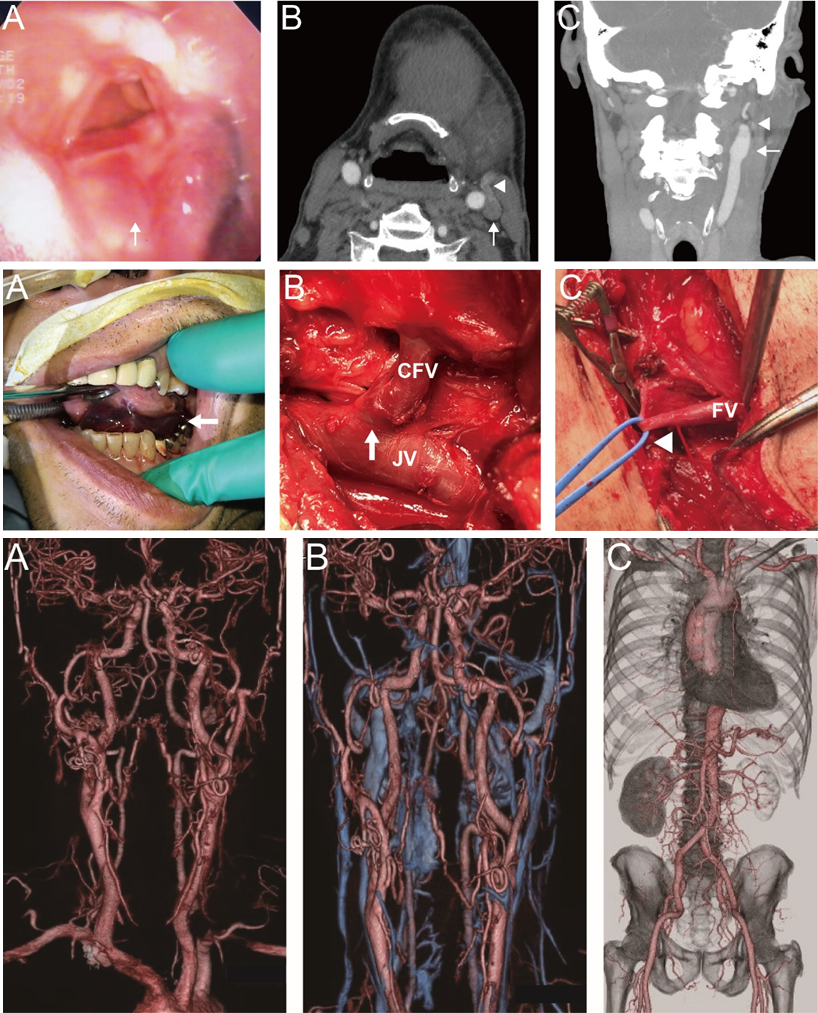Um caso de ruptura da veia facial induzida por tosse
Conteúdo do artigo principal
Resumo
Abscesso peritonsilar, infecção profunda no pescoço, epiglotite, edema laríngeo e corpos estranhos nas vias aéreas superiores são emergências frequentemente encontradas nas enfermarias de otorrinolaringologia. Em contraste, a ruptura vascular espontânea no pescoço é rara. Um homem de 57 anos visitou nosso hospital com dor no lado esquerdo do pescoço e início súbito de inchaço submandibular no pescoço após tossir. A tomografia computadorizada com contraste revelou uma lesão de massa mal realçada localizada na parte superior esquerda do pescoço. O inchaço mais proeminente foi observado ao redor da veia facial. Foi realizada a exploração da lesão de massa esquerda sob anestesia geral. Uma perfuração e fluxo intenso foram encontrados no ramo da veia facial comum esquerda. A perfuração foi ligada tanto no lado central quanto no periférico. Presumiu-se que a ruptura da veia facial fosse idiopática, possivelmente causada pela tosse. Relatamos o primeiro caso de ruptura da veia facial possivelmente induzida por tosse com inchaço maciço no pescoço e no assoalho oral. Para prevenir potenciais complicações, como estenose das vias aéreas devido ao inchaço do pescoço e o risco de choque hemorrágico, foi necessário realizar rapidamente diagnósticos por imagem e intervenção cirúrgica para obter hemostasia e remover o hematoma.
Detalhes do artigo

Este trabalho está licenciado sob uma licença Creative Commons Attribution 4.0 International License.
Authors retain the copyright of their articles and grant the journal the right of first publication under the Creative Commons Attribution (CC BY) license, which allows others to share and adapt the work with proper attribution.
Referências
Schappert, S.M. and E.A. Rechtsteiner, Ambulatory medical care utilization estimates for 2006. Natl Health Stat Report, 2008;(8):1-29.
Tsurumaki, N., M. Suzuki, S. Izumi, and M. Hojo, Rupture of a bronchial artery pseudoaneurysm after radiotherapy. BMJ Case Rep, 2024; 17(3).
Abreu, A.R., M.A. Campos, and B.P. Krieger, Pulmonary artery rupture induced by a pulmonary artery catheter: a case report and review of the literature. J Intensive Care Med, 2004; 19(5):291-6.
Li, J., X. Chen, and J. Zhou, Internal carotid artery rupture successfully rescued after resection of locally advanced mucosal malignant melanoma of the eustachian tube: a case report. J Int Med Res, 2020; 48(10):300060520963005.
Ota, Y., T. Aoki, K. Karakida, and M. Miyasaka, A case of rupture of the internal jugular vein caused by postoperative infection of functional neck dissection. Tokai J Exp Clin Med, 2001; 26(4-6):123-5.
Kooiman, A.L., J.M. Bakas, J.M.K. van Fessem, W.P.A. Boellaard, S.A.P. Cornelissen, and M.J.E. van Rijn, Spontaneous Iliac Vein Ruptures: A Systematic Review. Vasc Endovascular Surg, 2023; 57(6):617-625.
Okazaki, T., S. Shinagawa, and H. Mikage, Vasculitis syndrome-diagnosis and therapy. J Gen Fam Med, 2017; 18(2):72-78.
Bowen, J.M., G.J. Sobey, N.P. Burrows, M. Colombi, M.E. Lavallee, F. Malfait, and C.A. Francomano, Ehlers-Danlos syndrome, classical type. Am J Med Genet C Semin Med Genet, 2017; 175(1):27-39.
Germain, D.P. and Y. Herrera-Guzman, Vascular Ehlers-Danlos syndrome. Ann Genet, 2004; 47(1):1-9.
Ono, Y., E. Ueshima, N. Nakanishi, K. Shinohara, I. Yamada, and J. Kotani, Right thyrocervical trunk rupture after right internal jugular vein puncture: a case report and systematic review of the literature. JA Clin Rep, 2022; 8(1):74.
Luo, Y., H. Yuan, and Z.S. Cao, Residual foreign body in the neck after trauma results in the delayed rupture of the common carotid and internal jugular vein: a case report. J Med Case Rep, 2013; 7:13.
